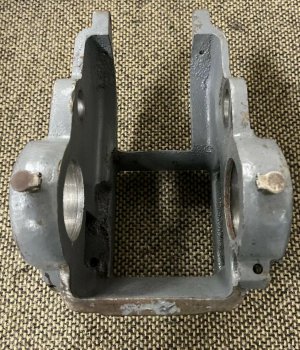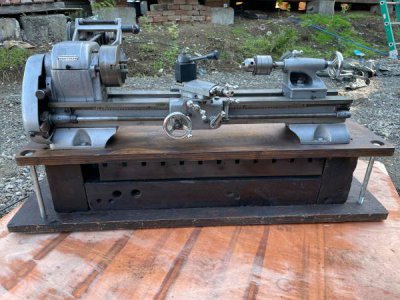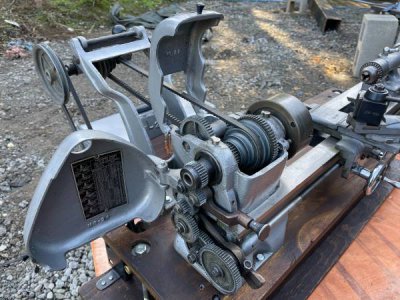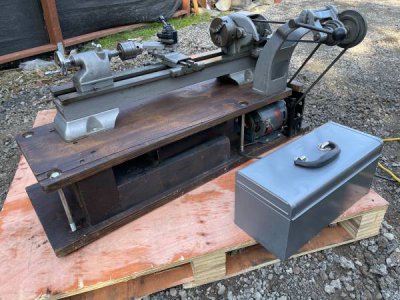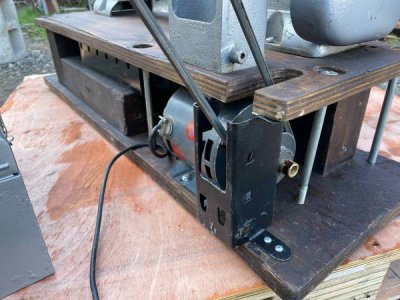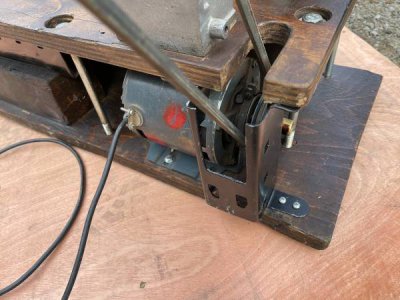I’ve been acquainting myself with the my 12” Craftsman lathes, have a location picked out in my shop, and have been doing some thinking on building a bench for it. I’ve also been doing some reading and comparisons as the underneath drive cabinet versions seem to package up nicely. It seems all of those cabinet models were being referred to as “Craftsman Commercial”.
Question 1: Does “Craftsman Commercial” refer to a specific set of features, upgrades, and/or model changes or is it just marketing? I ask because I see the cabinet models were not consistently referred to in that manner in the manuals.
I took a cursory look at the feasibility of such a conversion of my older horizontal drive 42” bench model and quickly discovered my headstock has no provision for bottom drive and the newer head stocks that do also house the back gears under the spindle so I discarded the idea and decided to stick with what I have. Then a local fella mentions he has a cabinet with headstock and bed, but everything else is gone, and I mean everything…….no carriage, tail stock, lead screw, and no gear train of any kind behind the headstock……but the spindle, back gears/engagement mechanism, and everything between the bearings is there, and so is the entire drive mechanism in the cabinet……..so that got me back on the subject of the possible conversion to underneath drive. This looks like it could become an (expensive) scavenger hunt and rabbit hole so thought I’d ask the experts if I’ve got it right.
I was hoping I’d just hang the gear train from the back of my older horizontal drive headstock on the new under drive version, and mount it on my existing bed, but it does not look to be that straight forward. At minimum, the reverse tumbler arm is different to accommodate the detent position in the newer style headstock, and possibly the gear train, banjo, etc.
Question 2: Is the rest of the gear train unique to the newer model headstock too?....and if it is, even if I’m able to collect those parts am I going to have difficulty interfacing with my existing lead screw? Will any of it interchange?
I did some downloads of manuals and illustrated parts references but the newer manuals in the Clausing era seem to have an entirely different part numbering system, so not much help there.
There also seem to be a number of different versions of end covers, and a unique set for underneath drives, with maybe even several variations within cabinet models.
I don’t know what kind of shape the bed is in on this local cabinet unit, but in my reading, I also found some discussion that said “Craftsman Commercial” beds had ½” thick ways while earlier versions were 3/8”. Is this so? It seems this would be no problem for the tail stock and the clamp could accommodate 1/8” difference in way thickness, but it may require some different shimming on the underside of the saddle/carriage.
Question 3: Will the carriage and tail stock assemblies from an early 12” Craftsman lathe interchange with a “Craftsman Commercial” or later version bed (if there is such a thing?). Is the rack, and are all the other interface dimensions the same?
Thanks in advance for your replies.
Best,
Kelly
Question 1: Does “Craftsman Commercial” refer to a specific set of features, upgrades, and/or model changes or is it just marketing? I ask because I see the cabinet models were not consistently referred to in that manner in the manuals.
I took a cursory look at the feasibility of such a conversion of my older horizontal drive 42” bench model and quickly discovered my headstock has no provision for bottom drive and the newer head stocks that do also house the back gears under the spindle so I discarded the idea and decided to stick with what I have. Then a local fella mentions he has a cabinet with headstock and bed, but everything else is gone, and I mean everything…….no carriage, tail stock, lead screw, and no gear train of any kind behind the headstock……but the spindle, back gears/engagement mechanism, and everything between the bearings is there, and so is the entire drive mechanism in the cabinet……..so that got me back on the subject of the possible conversion to underneath drive. This looks like it could become an (expensive) scavenger hunt and rabbit hole so thought I’d ask the experts if I’ve got it right.
I was hoping I’d just hang the gear train from the back of my older horizontal drive headstock on the new under drive version, and mount it on my existing bed, but it does not look to be that straight forward. At minimum, the reverse tumbler arm is different to accommodate the detent position in the newer style headstock, and possibly the gear train, banjo, etc.
Question 2: Is the rest of the gear train unique to the newer model headstock too?....and if it is, even if I’m able to collect those parts am I going to have difficulty interfacing with my existing lead screw? Will any of it interchange?
I did some downloads of manuals and illustrated parts references but the newer manuals in the Clausing era seem to have an entirely different part numbering system, so not much help there.
There also seem to be a number of different versions of end covers, and a unique set for underneath drives, with maybe even several variations within cabinet models.
I don’t know what kind of shape the bed is in on this local cabinet unit, but in my reading, I also found some discussion that said “Craftsman Commercial” beds had ½” thick ways while earlier versions were 3/8”. Is this so? It seems this would be no problem for the tail stock and the clamp could accommodate 1/8” difference in way thickness, but it may require some different shimming on the underside of the saddle/carriage.
Question 3: Will the carriage and tail stock assemblies from an early 12” Craftsman lathe interchange with a “Craftsman Commercial” or later version bed (if there is such a thing?). Is the rack, and are all the other interface dimensions the same?
Thanks in advance for your replies.
Best,
Kelly



